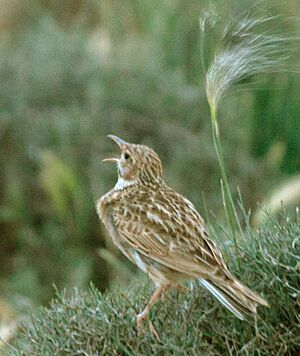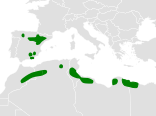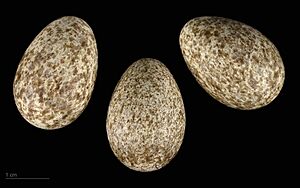Dupont's lark facts for kids
Quick facts for kids Dupont's lark |
|
|---|---|
 |
|
| Conservation status | |
| Scientific classification | |
| Genus: |
Chersophilus
|
| Species: |
duponti
|
 |
|
| Synonyms | |
|
|
The Dupont's lark (Chersophilus duponti) is a special type of lark bird. It belongs to the lark family, called Alaudidae. This bird is found in parts of northern Africa and Spain. It's the only species in its group, which is called Chersophilus.
Contents
What is a Dupont's Lark?
Dupont's lark is a small bird, about 17–18 centimeters long. That's about the length of a regular pencil! It looks quite plain, like many other larks. It has a slim body, long legs, and a slightly curved beak. You might notice a thin, light stripe on its head and dark streaks on its chest.
Different Types of Dupont's Lark
There are two main types, or subspecies, of Dupont's lark:
- North-western Dupont's lark (C. d. duponti): This type lives in southern Spain and northern parts of Morocco, Algeria, and Tunisia. It is mostly brown-grey.
- South-eastern Dupont's lark (C. d. margaritae): You can find this type from central Algeria all the way to western Egypt. It has more reddish-brown feathers on its back.
Its Special Song
This bird has a unique song. It's a soft, sad whistling sound that repeats. It's very hard to tell exactly where the sound is coming from! The Dupont's lark often sings at dawn (sunrise), dusk (sunset), or even at night.
Where Dupont's Larks Live
Dupont's larks live in many parts of northern Africa, from Algeria to Egypt. They also live in Spain and France. These birds do not migrate, which means they stay in the same area all year long. They like to live in areas with sandy ground and some low bushes, like chaparral or steppe lands.
Why They Need Our Help
Sadly, the number of Dupont's larks is going down, especially in Spain. Because of this, they are now considered a "vulnerable" species. This means they are at risk of becoming endangered if their numbers keep dropping. It's important to protect their homes so these special birds can continue to thrive.
How Dupont's Larks Behave
This bird is very shy! If it senses danger, it will quickly run for cover among the plants. It can be quite hard to spot when it's moving through the bushes. Sometimes, though, it will stand up tall on the edge of a small bush to sing its song.
Making a Home and Finding Food
Dupont's larks build their nests on the ground. The female bird usually lays three or four eggs. For food, these larks eat both seeds and insects.



